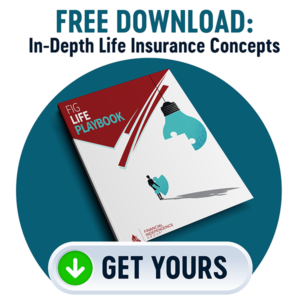Updated August 16, 2023, at 10:15 AM
As part of Life Insurance Awareness Month, let’s look at the question of whether you should get term or permanent (perm) life insurance.
Actually, you may want to have components of both. That’s because term components should make a transition to perm, and avoid slipping back to term.
We need to rethink what permanent life insurance is. To have permanent life insurance, there needs to be values that persist. The permanent portion should be cash value or another internal value that does not decrease unless distributions are taken. The premium or total benefit may need to be adjusted from time to time to allow for this permanent value.
Term vs. Perm Life Insurance
Term life insurance typically has no cash value and only pays a benefit at death. In today’s market, term life typically focuses on 10 to 30 years of coverage with a level premium during these years. After the level premium years, the policy premiums jump up to annual renewable term (ART) rates that increase each year. Term life insurance is also provided with low ART premiums at policy issue, but these rates increase steadily and become quite high in retirement.Life insurance that isn’t term insurance is often called permanent, or perm. The problem is that the market has created flexible options and scenarios where these policies are not permanent. They can backslide into effectively being term insurance where the costs in retirement are high and impractical.
One definition of permanent life insurance I recently came across read that it is: “Coverage that you can’t outlive as long as you pay your premiums. Allows you to build cash value that you can use while you’re alive in whatever way you see fit.”
This definition often doesn’t work for universal life policies, though. While whole life requires a fixed premium to keep the policy permanent, universal life allows flexible premiums that may not be enough to make the policy permanent. Universal life administration systems should—but typically don’t—tell you how to adjust the premium or benefit to make the policy permanent.
Reviewing Policies is a Smart Move
You should regularly review universal life to see if it needs to be adjusted. If you continue low premiums long enough, tax guideline premium limits may force the policy to use up the cash value for insurance costs. After the cash value is used up, you are allowed to pay the ART premiums to keep the policy going. These ART premiums typically would start between age 80 and 90 with costs that are impractical.
If you use up the cash value in distributions (withdrawals or loans), you could also outlive the policy with a taxable gain on any gain tied to the loan balance. This is true for whole life, universal life and other life insurance policy that allow loans secured by gains in the policy. These policies need to be reviewed regularly to adjust for changes in returns, costs, outlays or financial goals.
Advocates of term life insurance over perm say you should buy term and invest the difference in premium. In effect, you are building your permanent values by separate savings and investments. Advocates of perm life insurance note that people who buy term often do not invest the difference and perm offers long-term tax advantages for cash value when properly funded.
Related: When I’m 64: Guidance for Life Insurance in or Near Retirement
With either approach, you need to find a balance and fund the plan to build up permanent values. If you carry term life insurance too long into retirement, high costs on a large policy can eat into your savings and investments. If you have a cash value life insurance policy that carries too much of these term components into retirement, values are used up and perm becomes term.
The simplest form of permanent life insurance is a single premium policy that is guaranteed for life. Single premium whole life is a great example. It is also called a “paid-up policy”. The cash value is guaranteed to grow and endow the policy benefit at maturity. Dividends would increase the values and benefits.
There’s also single premium universal life that guarantees cash value or guarantees the death benefit for life with or without cash value. Index credits or other credit options would allow values and benefits to increase—perhaps even more than dividends would due to trade-offs with guarantees.
Other premium options for permanent life insurance include 10 pay, 20 pay, or paid-up at age 65/85/100. Whole life has these premium options. Universal life (including indexed and variable types) has similar premium options where premiums are paid at or near the tax limits. For universal life these tax limits, include policy value factors that increase the death benefit when the policy value is high enough.
Corridor & Cash Value Accumulation
These factors include two options at policy issue: one called the corridor and the other is a cash value accumulation test that is like a net single premium in whole life. Policies in or near these policy value factors typically are permanent paid-up policies.
For example, the corridor at age 40 requires that a $100,000 policy value have a minimum death benefit of $250,000. At age 60, a $100,000 policy value requires a minimum death benefit of $120,000. By age 95, a one-to-one ratio of policy value to death benefit is allowed. The cash value accumulation test and whole life net single premiums typically require a higher minimum death than the corridor factor with the same policy value.
When is a policy permanent with an ongoing premium?
Should we say a policy is permanent if premiums can be paid to keep the policy for life?
If so, then even term life insurance with ART premiums for life would be permanent. We could modify the definition by saying a permanent policy should not require an increasing premium. Should we exclude policies with cash value that would later require a premium increase?
The key to a practical definition of permanent life insurance is that it has a policy value that persists. The permanent portion is a value that does not decrease even though the death benefit may need to decrease by decreasing the term component.
Whole, Universal, & IUL
Whole life on the other hand, forces a decreasing term component. If you want to stop paying premiums, you have the option to go to a reduced paid-up (RPU) policy that would grow if there are future dividends added to the policy. Some whole life policies also allow a gradual decreasing benefit that surrenders base cash value to pay the premium. If dividends are enough to pay the premium, the benefit can increase with any excess dividend.
Universal life needs better policy service to give regular notices of what premium is needed to keep the policy for life and what benefit decrease would be needed to prevent the policy value from decreasing. A few companies do now provide notice of how to adjust the premium.
Some companies are even starting services for new policies that will give notice of how to optimally reduce the benefit when you start taking policy distributions and when needed for loan protection. Guidance is needed for all universal life policies. Policyholders need these decrease options in retirement and need exceptions to minimum decrease rules to allow a gradually decreasing benefit. This service is the only way I see to fulfill the expectation of permanent life insurance while having flexible premiums and credits.
Indexed universal life has policy value decreases when there is no index credit or a low credit where the credit plus premium are not enough to cover the costs for the year. For these cases in retirement, you might delay a benefit decrease to allow time for higher index credits or look at what the fixed account can support. Variable universal life has similar, but more volatile dynamics as there can be losses in the accounts.
Related: Finding the Right Indexed Universal Life Insurance Policy
When universal life is illustrated, the agent may show the premium that is projected to provide $1 or some other minimal policy value at age 100. This approach is viewed as showing the lowest premium to provide permanent insurance, but it is deceptive. The premium to provide endowment (policy value = face amount) would only be slightly higher. This is due to the cost of insurance and cash value dynamics to age 100. Also, the premium needed will change due to changing credit rates and any changes in current costs.
In the illustration for $1 at age 100, typically the policy value would reach a peak about 10 years prior at age 90 and then the policy value decreases rapidly to a $1 at age 100. The peak policy value would equal over half of the face amount. If the policy value steadily decreases and the insured can outlive the policy then it is not permanent. Instead, if the benefit were gradually decreased, this policy value would be a permanent amount even if the insured lived beyond age 100.
Guaranteed universal life (GUL) provides a secondary way to guarantee a death benefit without long-term cash value. GUL can be permanent life insurance even when the cash value decreases, but an internal policy value or shadow account has the same dynamics as noted above. To keep a permanent portion, adjustments may be needed to prevent the internal policy value from decreasing or getting off track. The policyowner may need to add in more premiums to keep the benefit permanent.
These premiums may catch-up for premiums that were missed or that were paid too early or too late. The alternative to adding premiums would also be a decreasing benefit to prevent the internal policy value from decreasing.
Final Thoughts
The same concepts apply to guaranteed values without secondary guarantees. These illustrated values use worst case assumptions and the scenario is typically unlikely. Even so, if adjustments were made to premiums or benefits, a permanent value could be shown and serviced. The message of how the policy would be serviced to be permanent is the key.
Simply, permanent life insurance needs to be values that persist. The permanent portion should be cash value or other internal value that does not decrease unless distributions are taken. The premium or total benefit may need to be adjusted from time to time to allow for this permanent value.
Video: Term and Perm Life Insurance
The content within this document is for informational and educational purposes only and does not constitute legal, tax, or investment advice. Customers should consult a legal or tax professional regarding their situation. This document is not an offer to purchase, sell, replace, or exchange any product. Insurance products and any related guarantees are backed by the claims-paying ability of an insurance company. Insurance policy applications are vetted through an underwriting process set forth by the issuing insurance company. Some applications may not be accepted based upon adverse underwriting results.
Some types of permanent insurance may require consistent premium payments, or the policy may risk lapsing. Unpaid policy loans decrease future death benefits paid to beneficiaries. Excessive policy loans may cause the need for future premium payments. If a contract lapses due to excessive policy loans or if a customer chose to surrender their policy, one may be subject to tax payments for policy loans that exceed the premiums paid. Excessive premium payments may cause the policy to become a modified endowment contract. Policies classified as modified endowment contracts may be subject to taxes when a loan or withdrawal is made.



